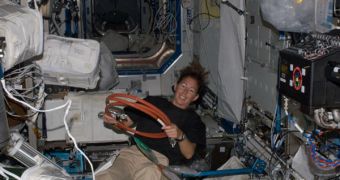NASA astronaut Sandra Magnus will return home to the United States on Saturday, after spending roughly 4 months in the weightlessness of Earth's lower orbit. She is bringing home a very distinct talent that is sure to leave all other women a bit jealous – the ability to cook at zero-gravity. And if you think that's easy, you try chopping onions while everything flies around you. In addition, it's not like fire sources shoot their flames upwards in space, but rather they spread it around.
Her career as an orbital chef got off to a pretty doubtful start, when Magnus first tried to mix several packaged products in a new type of food. “In the end, it was a mediocre product since the original base dish already had an overwhelming flavor to it,” the astronaut meekly wrote in her diary, which she kept throughout the voyage. After that day, she was hooked on it.
Often, she would spend her free time on Sunday evening cooking for her crew mates, commander Michael Fincke and flight engineer Yuri Lonchakov. “Whenever I cook, I know the guys enjoy just the different flavors and the different flavor combinations that I came up with,” she said in an interview. But she also invented revolutionary ways of cooking or preparing other types of food in her house as well, including the use of sealed plastic bags, for mixing, the slicing of larger pieces, instead of smaller ones, and the use of duct tape to keep all the pieces in place.
“Duct tape is useful. You can set it out on the table with the sticky side up. This works for everything from trash to onion and garlic peelings and lemon peel. It does get messy but you can roll up the used tape with the stuff on it, throw it away, and get out a new strip,” one of her journal entries read. “To prepare garlic, and I have added onions to the mix, you keep some of the foil packets that the Russian dehydrated food comes in, put the garlic and chopped onion (large pieces) in the foil, squirt in some olive oil, fold the foil over to fit into the food warmer and turn it on,” she added, as quoted by Irene Klotz.
“The warmer only works for 30 minutes or so, so every half hour you have to come in and turn it on again. After about four or five cycles, you have cooked garlic and onions,” Magnus shared. She used this technique numerous times, to prepare various types of sauces for all sorts of meat and fish the crew had onboard. Plus, she could always rely on the Russians to send up more garlic, with each transport.

 14 DAY TRIAL //
14 DAY TRIAL //